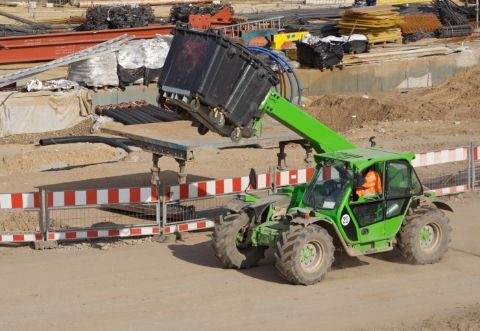Prevent damage to agricultural and earth-moving tyres
External influences
Climate is one of the factors which influence life-span. Other causes can be attributed to use, under-surface and the mechanical forces placed on tyres. This includes, for example, the regular ‘impact’ of profile ridges on slippery or hard under-surfaces when travelling at high speed. So speed should be modified depending on the under-surface and the used tyres.
Lateral forces also have an impact, e.g. when going around sharp bends (too sharply). In this case, the speed of the vehicle and the radius of the bend will play a major role, as will the driving lines followed when manoeuvring.
Or collisions with rough components in the under-surface, like rubble, driving plates, tree trunks, etc. This will be partly determined by the area where tyres are deployed. The causes above can, for the most part, be countered by an appropriate and vigilant driving style.
Other causes for damage to agricultural and earth-moving tyres
There is a direct correlation between tyre pressure and tyre life-span, which can be reduced considerably as a result of low or high pressure.
- If pressure is too low, this places excessive load (deformation) on the edges, which in-turn leads to very high temperature in the centre of the tyre and unequal wear and tear to the profile.
- If pressure is too high, this results in premature wear and tear to the tread and makes tyres susceptible to incisions and collisions with rough objects.
It is thus important to check tyre pressure on a regular basis - this will help to avoid many problems.
Overloading causes an increase in temperature and major deformation at the edges, with the sides being particularly susceptible. This means tyres need to be replaced even though the tread is still in good condition. Excessive speed also results in damage because it is accompanied by very high temperatures; and tyres are only suitable up to a particular temperature. This factor primarily influences the life-span of the carcase.
Overheating in tyres is normally caused by the tread coming loose from the carcase, which will have been caused by excessive temperatures in some parts of the tyre. Overheating is caused by the above-mentioned factors, but also occurs when tyres do not perform enough complete revolutions, which means they cannot release all of the generated heat.
Naturally, a tyre's position on the vehicle also has an impact on wear and tear. On average, tyres on the drive axle have a 20% shorter life-span; this does not apply to reach stackers, where the opposite applies.
Finally, vehicle maintenance also has an impact. Ineffective brakes cause wheels to heat up, which then has an effect on tyres. Tyres will also suffer more wear and tear if vehicles are poorly balanced or aligned. Poor shock absorption places extra pressure on the tyres, which causes them to wear at a faster rate. So prevent damage by selecting tyres which are suitable for specific purposes. And look after your tyres.
Like to know more?
Do you need advice? Please contact us, our experts will be pleased to assist you. Contact our experts at +31 (0)523 - 850 850 or by e-mail to info@heuver.com. You can read all of our articles on our knowledge-page.

